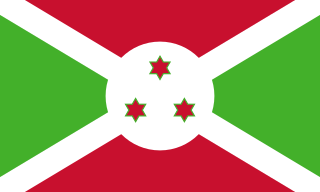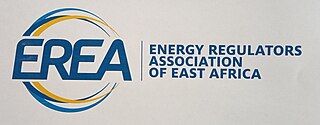
Kenya maintains relations with various countries around the world. Its closest ties are with its fellow Swahili-speaking neighbors in the African Great Lakes region. Swahili speaking neighbours mainly include countries in the East African Community such as Burundi, Rwanda, South Sudan, Tanzania and Uganda. There's also the DRC which has a significant Swahili speaking population.

Rwanda, officially the Republic of Rwanda, is a landlocked country in the Great Rift Valley, where the African Great Lakes region and East Africa converge. Located a few degrees south of the Equator, Rwanda is bordered by Uganda, Tanzania, Burundi, and the Democratic Republic of the Congo. It is highly elevated, giving it the soubriquet "land of a thousand hills", with its geography dominated by mountains in the west and savanna to the east, with numerous lakes throughout the country. The climate is temperate to subtropical, with two rainy seasons and two dry seasons each year. Rwanda has a population of over 12.6 million living on 26,338 km2 (10,169 sq mi) of land, and is the most densely populated mainland African country; among countries larger than 10,000 km2, it is the fifth most densely populated country in the world. One million people live in the capital and largest city Kigali.

The East African Community (EAC) is an intergovernmental organisation composed of seven countries in the African Great Lakes region in East Africa: Burundi, the Democratic Republic of the Congo, Kenya, Rwanda, South Sudan, Tanzania, and Uganda. Uhuru Kenyatta, the president of Kenya, is the current EAC chairman. The organisation was founded in 1967, collapsed in 1977, and was revived on 7 July 2000.
The East African Development Bank (EADB) is a development finance institution with the objective of promoting development in the member countries of the East African Community.

The Economic Community of Central African States is an Economic Community of the African Union for promotion of regional economic co-operation in Central Africa. It "aims to achieve collective autonomy, raise the standard of living of its populations and maintain economic stability through harmonious cooperation".
The Inter-University Council for East Africa (IUCEA), is an institution of the East African Community, which is a regional intergovernmental organisation of the republics of Kenya, Tanzania, Uganda, Burundi, Rwanda and South Sudan. IUCEA aims to foster collaboration between universities in the EAC region. It has its head offices in Kampala, Uganda

The African Union (AU) is a continental union consisting of 55 member states located on the continent of Africa. The AU was announced in the Sirte Declaration in Sirte, Libya, on 9 September 1999, calling for the establishment of the African Union. The bloc was founded on 26 May 2001 in Addis Ababa, Ethiopia, and launched on 9 July 2002 in Durban, South Africa. The intention of the AU was to replace the Organisation of African Unity (OAU), established on 25 May 1963 in Addis Ababa by 32 signatory governments; the OAU was disbanded on 9 July 2002. The most important decisions of the AU are made by the Assembly of the African Union, a semi-annual meeting of the heads of state and government of its member states.
The treaty for the establishment of the East African Community was signed on 30 November 1999 and entered into force on 7 July 2000 following its ratification by the original three Partner States – Kenya, Uganda and Tanzania. The Republic of Rwanda and the Republic of Burundi acceded to the Treaty on 18 June 2007 and became full members of the Community with effect from 1 July 2007. The accord established the East African Community whereby all participating nations agreed to establish more cooperative commercial and political relations for their cumulative 133 million citizens. The treaty went into effect on July 7, 2000.

The East African Federation is a proposed political union of the seven sovereign states of the East African Community – Burundi, the Democratic Republic of the Congo, Kenya, Rwanda, South Sudan, Tanzania and Uganda – as a single federated sovereign state. In September 2018, a committee was formed to begin the process of drafting a regional constitution, and a draft constitution for the confederation was set to be written by the end of 2021 with its implementation by 2023; however, it is likely that this deadline will be missed.

Burundi, officially the Republic of Burundi, is a landlocked country in the Great Rift Valley where the African Great Lakes region and East Africa converge. It is bordered by Rwanda to the north, Tanzania to the east and southeast, and the Democratic Republic of the Congo to the west; Lake Tanganyika lies along its southwestern border. The capital cities are Gitega and Bujumbura, the latter of which is the country's largest city.

Richard Sezibera is a Rwandan medical doctor, diplomat and politician, who served as the Minister of Foreign Affairs from 18 October 2018 until November 4, 2019. He replaced Louise Mushikiwabo. He was replaced by Vincent Biruta on November 4, 2019.
Prostitution in Burundi is illegal but is commonplace and on the rise. Prostitution is prevalent in all areas of the country, and especially in the largest city, Bujumbura, and prior to the security crisis in 2015, the tourist areas around Lake Tanganyika. UNAIDS estimate there are 51,000 prostitutes in Burundi. Many women have turned to prostitution due to poverty.

Kenya – Rwanda relations are the bilateral relations between Kenya and Rwanda. Kenya is a partner of Rwanda in many areas, particularly trade, security (military), education, agriculture and energy.
Libérat Mfumukeko is a Burundian diplomat and civil servant. He served as the Secretary General of the East African Community (EAC) from 2 March 2016 to 2 March 2021, replacing Richard Sezibera.

The emblem of the East African Community is the emblem used since 2008 by the East African Community, an intergovernmental organisation composed of six countries in the African Great Lakes region in eastern Africa.

The 17th EAC Extra Ordinary summit was held on 8 September 2016 in Dar es Salaam, Tanzania. The summit was held with regards to the European Union and East African Community Economic Partnership agreement. Furthermore, the unrest in Burundi and South Sudan was discussed.
Science and technology in Uganda examines government efforts to develop a national innovation system and the impact of these policies.

Countries of the East African Community (EAC) include Kenya, Tanzania, Burundi, Uganda, Rwanda, and South Sudan. These nations fall below par in different measures of economic activities such as GDP per capita, population below the poverty line, unemployment, and trade. The East African Community has made an effort to bolster trade through enhancing co-operation economically, socially, and politically within the member nations. "The aim of EAC is to gradually establish among themselves a Customs Union, a Common Market, a Monetary Union, and ultimately a Political Federation of the East African States." East African Community countries also have active trade to other parts of the world, like the European Union. Each country is a part of the World Trade Organization except for South Sudan who remains out of this conglomeration. As of 2014, these six countries have a combined GDP of $159.5 billion, GDP per capita of $918, total population of 168.5 million, total import $40.2 billion, and total export $13.6 billion. These countries become much stronger as a part of the community as they become a larger market for trade outside of the bloc. Also, the bloc allows for free trade between the member countries helping not only producers who have more options to sell their product but also consumers who have more cheap goods. It is always important for fish to be in fresh water lakes

The 20th EAC Ordinary summit was held on 1 February 2019 in Arusha, Tanzania. The summit was rescheduled twice from November 2018 and December 2018 due to the absence of Burundi. The focus of the summit was to arrive on a conclusion for the EU-EAC EPA agreement and to further grow domestic manufacturing in the region. The leadership of the community was transferred from Yoweri Museveni of Uganda to Paul Kagame of Rwanda.

The Energy Regulators Association of East Africa (EREA) is a non-profit organisation mandated to spearhead harmonisation of energy regulatory frameworks, sustainable capacity building and information sharing among the List of energy regulatory bodies in the East African Community. Its key objective is to promote the independence of national regulators and support the establishment of a robust East African energy union.











